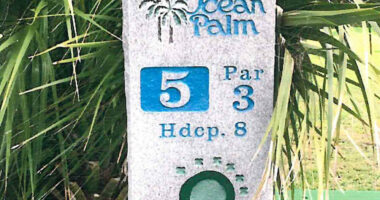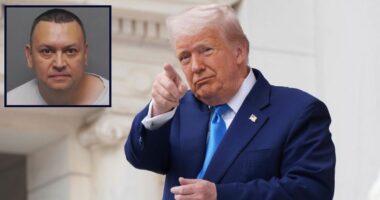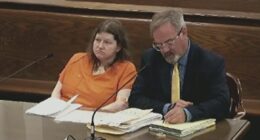
Donald Trump speaks at the annual Road to Majority conference in Washington, DC, June 22, 2024 (Allison Bailey/NurPhoto via AP)
Attorneys for Donald Trump on Tuesday tried yet again to have their client’s hush-money case moved to federal court — after their latest effort to do so was rejected by a federal judge as “deficient” last week.
On Aug. 29, the former president’s defense team submitted nearly three dozen documents with the U.S. District Court for the Southern District of New York, asking Senior U.S. District Judge Alvin Hellerstein to remove the case to federal jurisdiction.
In the second removal notice, attorneys Todd Blanche and Emil Bove pleaded for the court to take the reins of the “zombie” case away from both Manhattan District Attorney Alvin Bragg and New York Supreme Court Justice Juan Merchan. The removal filing cites “evidence of local hostilities” as well as repeat “violations” of the recent U.S. Supreme Court’s landmark ruling on presidential immunity.
On Aug. 30, a docket entry rejected Trump’s removal effort as a “deficient pleading” for various, and enumerated, reasons.
“The filing is deficient for the following reason(s): the PDF attached to the docket entry for the pleading is not correct; the wrong event type was used to file the pleading; Court’s leave has not been granted; the order granting permission to file the pleading was not attached,” the bolded docket entry reads.
The court went on to explain how to properly file the request the next time around. Most of the advice — and the mistakes the advice is meant to address — concerns basic filing errors. But the court also advised Trump’s team they needed to refile with the government’s consent or leave of court — and dinged the lawyers for not having leave of court, which means the court’s consent, in the first place.
On Tuesday, Blanche and Bove filed two new motions.
In a notice of motion, Trump’s attorneys asked “the Court for an order granting leave to file” their previously-rejected removal request.
The removal notice tersely references three federal statutes in an effort to secure the court’s permission to move forward.
The first statute contains basic timelines for removal as well as a “good cause” exception the defense is likely to try and avail itself of.
The second statute outlines some of the legal argumentative requirements necessary to secure removal. Of particular importance for Trump is the requirement that “a second notice may be filed only on grounds not existing at the time of the original notice.”
The third statute is one line — often liberally interpreted — that reads: “Defective allegations of jurisdiction may be amended, upon terms, in the trial or appellate courts.” Essentially, this statute offers federal courts substantial leeway to help defendants fix their mistakes and guide them toward the proper way out of certain jurisdictions.
In an accompanying memorandum of law filed simultaneously with the notice seeking leave — as well as the refiled second removal notice — Blanche and Bove briefly, almost in a conclusory fashion, argue how each of the three aforementioned statutes apply to the present case.
The memo reads, in relevant part:
On August 30, 2024, [a docket] notice was entered directing President Trump to “RE-FILE” the Second Removal Notice with, inter alia, the “Court’s leave.” Based on conversations with the Clerk’s Office this morning, September 3, 2024, President Trump is submitting this motion seeking that relief. For the reasons set forth in paragraphs 12 and 116 — 146 of the Second Removal Notice, President Trump respectfully submits that (1) there is “good cause” for the filing of the Second Removal Notice under 28 U.S.C. §§ 1455(b)(1) and 1455(b)(2) …
Or, in other words, Trump’s attorneys are referring to the previously-filed — and rejected — second removal notice while explicitly singling out the first two statutes mentioned above. This, the filing suggests, should be enough to secure leave of court.
In the sections cited, Trump’s attorneys argue good cause primarily exists for removal “because of the extraordinary significance of the Presidential immunity doctrine recently articulated by the Supreme Court in Trump v. United States.”
The removal effort goes on to argue that two other “intervening decisions” by the nation’s high court support good cause — and quickly summarizes cases dealing with federal officer removal and regulatory agency interpretations of statutes.
As Law&Crime previously reported, removal arguments also focused on the alleged behavior and biases of Bragg and Merchan.
“[Bragg] represented to the Court that their case would not involve evidence of President Trump’s official acts,” the motion argues. “That proved to be not true. They also represented to the Court that their legal theory did not require consideration of FECA-related disclosures. That was not true, either.”
As for the trial judge, Trump’s effort focuses on Merchan’s daughter’s role as an in-demand Democratic Party consultant who has worked for various of Trump’s political enemies.
“This month, President Trump renewed prior requests for Justice Merchan’s recusal based in part on 2019 public statements by Justice Merchan’s daughter indicating that he had been critical of President Trump’s use of Twitter during his Presidency,” the motion goes on. “The problem with Justice Merchan’s earlier statements is that they confirm judicial bias and hostility towards President Trump’s 2018 Tweets, which are a core issue in the pending Presidential immunity motion.”
Notably, Trump’s attorneys have filed an “in the alternative” argument — seeking leave to amend their first removal notice “based on intervening Supreme Court decisions and DANY’s trial presentation is appropriate pursuant to 28 U.S.C. § 1653.”
That first bite at the federal removal apple was pawed away in late July 2023 by the same judge Trump is asking to reconsider things now.
In an order, Hellerstein observed: “Trump has failed to show that the conduct charged by the Indictment is for or relating to any act performed by or for the President under color of the official acts of a President. Trump also has failed to show that he has a colorable federal defense to the Indictment.”
Matt Naham contributed to this report.
Have a tip we should know? [email protected]







